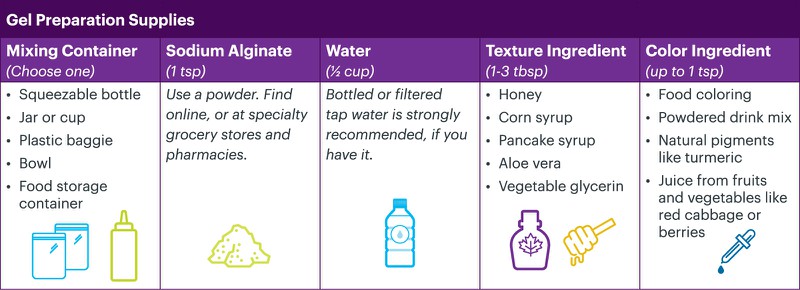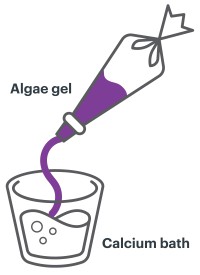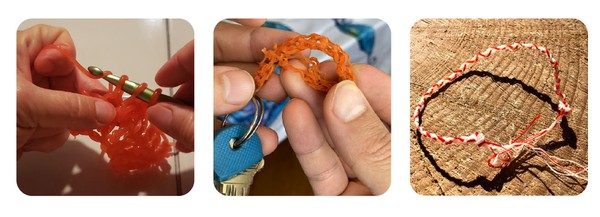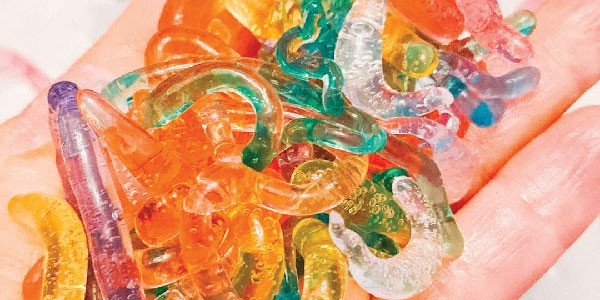Summary
Introduction
Did you know that the seaweed you've seen in the ocean or even eaten as a snack is inspiring innovators to imagine new materials? Large brown algae, like kelp, contains polymers—long chains of molecules—that are more environmentally friendly than the ones in most plastics. These natural polymers (alginates) could eventually be used to create sustainable everyday objects. Try your hand at using a bit of chemistry to turn biodegradable polymers from algae into your own custom string! Educators, a lesson plan is also available for this topic.
Design Challenge
Make your own colorful string using polymers that come from algae. Then craft fun creations with your algae string!
Materials
You will need two special ingredients, sodium alginate (algae polymer) and calcium chloride. These are the chemistry superstars that react together to form a new material! You'll also need some basic kitchen equipment and supplies to customize your string. We have included our favorite suggestions below to get you started, but use whatever you have on hand—be creative!
Do not eat the resulting algae string; this activity was not designed with consumption in mind.
 Image Credit: The Tech Museum / The Tech Interactive
Image Credit: The Tech Museum / The Tech InteractiveTo prepare the gel, you will need the following items. One mixing container such as a squeezable bottole, jar, cup, plastic baggie, bowl, or food storage container, A teaspoon of sodium alginate; found online, or at specialty grocery stores and pharmacies. One-half cup of water; bottled or filtered tap water is strongly recommended, if you have it. One to three tablespoons of a texture ingredient like honey, corn syrup, pancake syrup, aloe vera, or vegetable glycerin. Up to one teaspoon of a color ingredient like food coloring, powdered drink mix, natural pigments like tumeric, or juice from fruits and vegetables like red cabbage or berries.
Note: Some Mixing Containers will need a utensil to stir. Some can double as a Dispensing Tool. (View a larger version of the Gel Preparation Supplies.)
 Image Credit: The Tech Museum / The Tech Interactive
Image Credit: The Tech Museum / The Tech InteractiveTo make the string, you will need the following items. One bath container such as a bowl, food storage container, pan, or baking dish. Two cups of water; any type, including tap water, will work. Two teaspoons of calcium chloride; found online or at brewing supply stores. One or more dispensing tools such as a squeezable bottle, jar or cup, plastic baggie, piping bag, or a syringe without a needle.
Note: Bath Container should be large enough to reach into and make a bath that is at least one inch deep. (View a larger version of the String Making Supplies.)
Disclaimer: Science Buddies participates in affiliate programs with Home Science Tools, Amazon.com, Carolina Biological, and Jameco Electronics. Proceeds from the affiliate programs help support Science Buddies, a 501(c)(3) public charity, and keep our resources free for everyone. Our top priority is student learning. If you have any comments (positive or negative) related to purchases you've made for science projects from recommendations on our site, please let us know. Write to us at scibuddy@sciencebuddies.org.
- Why filtered water? Many homes have hard water, which has minerals like calcium. Since calcium is used in the chemical reaction, your algae gel could solidify too soon!
- Why texture ingredients? These sticky substances help keep your string from becoming stiff and breakable.
- Why a dispensing tool? This handy tool will help you shape your gel before you transform it into a solid string. Remember some mixing containers can also be used as dispensers.
Instructions
| Time | |
|---|---|
| Prepare gel | 1 hr-1 day |
| Make string | 30 min |
| Create | 30 min-4 hours |
Part 1: Prepare your algae gel (1 hr-1 day)
The basis of your string will be algae gel, a gooey combination of ingredients you mix to your own specifications. Watch how your adjustments to the color and texture affect your string later!
- Choose the texture and color ingredient(s) you want to use to customize your algae string. Add them to a mixing container with water and mix to combine.
1/2 cup Water (filtered or bottled recommended) 1-3 tbsp Texture Ingredient(s) (honey, etc.) Up to 1 tsp Color Ingredient(s) (food coloring, etc.) Tip: Make more batches to experiment with different combinations or multiple ingredients!
- Add in the sodium alginate powder. Mix until a thick gel begins to form (about 5 min).
1 tsp Sodium Alginate Powder - Your algae gel will be ready to use when there are no more powder clumps.
Excited to make string right away? Mix by hand. Tired of mixing? Let it sit overnight. - Continue to actively mix your gel until all clumps have broken up and dissolved.
- This will take some effort and time (30 min or more), but can be a fun challenge!
- The air bubbles trapped in your gel won't have time to escape, which may weaken your string.
- Clumps will finish dissolving by themselves as your gel rests.
- Seal or cover your container to stop your gel from drying out while it sits.
- This extra time also allows air bubbles to escape, which can strengthen your string.
- Video: What's the Chemistry? Zoom in for a peek at the chemistry that turns your gel into a solid string.
- Algae String Essential Questions Such as... will this clog my sink?
Part 2: Make your algae string (30 min)
It's time to use chemistry to change your gooey gel into a solid string. The chemical reaction will start when the alginate in your algae gel meets the calcium in your calcium bath.
- Combine water and calcium chloride in your bath container and mix to make the calcium bath. (You can reuse your bath for several batches of string.)
2 cups Water (any type) 2 tsp Calcium Chloride - Transfer your algae gel into a dispensing tool of your choice.
- Use your dispensing tool to add your algae gel to the calcium bath.
- Depending on the tool used, pour your gel from above or push it through a small opening, like squeezing toothpaste from a tube!
- To avoid clogs, keep your dispensing tool from touching the bath.
 Image Credit: The Tech Museum / The Tech Interactive
Image Credit: The Tech Museum / The Tech Interactive
- Let your string sit in the calcium bath for a few minutes before removing.
- Give it a test squeeze. If it isn't as solid as you want, put it back in to soak longer.
- Video: How Dried String Changes: Fresh string is squishy—what happens as it dries?
- Algae String Tool Chest Learn how tools affect your gel and string.
Part 3: Create some custom algae string creations! (30 min-4 hours)
See what you can make with your algae string! Can you tie it into a bow? Or use knots to make a bracelet? Try using it to knit or weave an awesome creation!
 Image Credit: The Tech Museum / The Tech Interactive
Image Credit: The Tech Museum / The Tech Interactive
| Like your wet string? Start creating! | Want something more stable? Let your string dry. |
|
|
Note: You can dispose of leftover algae gel and unwanted string in the trash. Pour your calcium bath down the drain.
Explore More
- Customize! Make multiple batches of string that are different colors, shapes, or thicknesses. How about a more stiff or flexible string?
- All strung out? Make a 2D creation! Trace your algae gel into a pattern on a plate, then gently pour your calcium bath around it until it's completely covered. What other creations can you make?
- New tools. Use materials from around your house to build a new type of dispensing tool. What kind of string does it make?
- Video: Algae String Ideas: Find some ideas for things to create!
- Activity: Algae String Mizuhiki Knots Learn how to tie your own!
Additional Resources
- The Tech Interactive at Home: Algae String
- Algae String Activity Guide (PDF)
- Lesson Plan: Algae String Chemistry and Design
 Image Credit: The Tech Museum / The Tech Interactive
Image Credit: The Tech Museum / The Tech Interactive
This activity was developed by The Tech Interactive with funding from a Science Education Partnership Award (SEPA) from the National Institute of General Medical Sciences (NIGMS) at the National Institutes of Health (NIH).






